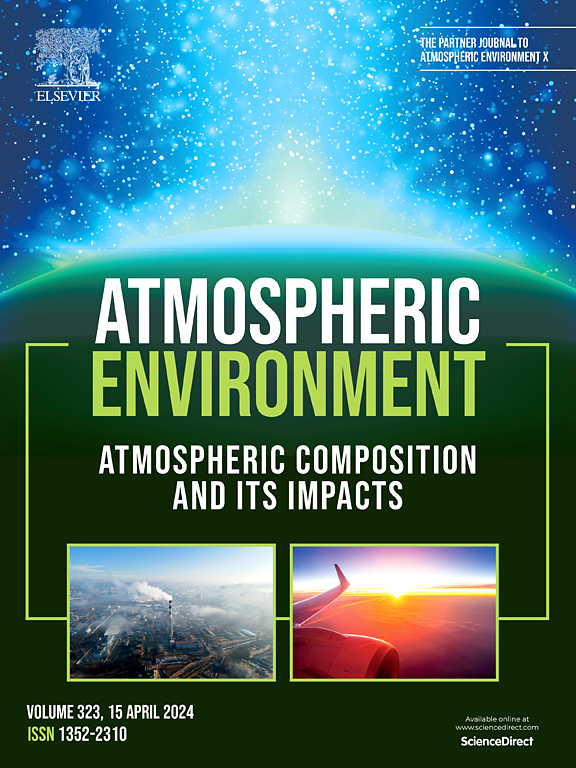基于台站观测和卫星资料的西藏高原紫外线辐射时空变化
IF 4.2
2区 环境科学与生态学
Q2 ENVIRONMENTAL SCIENCES
引用次数: 0
摘要
利用1961-2022年臭氧监测仪器(OMI)和全球臭氧监测实验2 (GOME-2)卫星数据和地面观测数据,对西藏省县级UVR进行了系统、长期的分析。分析了紫外线指数(UVI)、中波紫外线(UVB)和中波紫外线(UVA)等参数的时空特征及其影响因素。2005-2022年,UVA、光谱辐照度(I310:310 nm、I324:324 nm和I380:380 nm)呈显著上升趋势,Sen’s斜率值均超过0.51。西藏各县红斑日剂量、UVA、UVB平均值分别为24.85 ~ 37.79、3.32 ~ 5.10、903 ~ 1330 (kJ/m2),较高值分布在日喀则、拉萨和山南南部地区。所有县的人口加权紫外线指数都超过8.65,根据世界卫生组织的紫外线指数分类,84.27%的人口被归类为经历“极端”紫外线暴露。UVR占太阳表面辐射的比例呈现西高东低的趋势,夏季达到峰值,冬季下降,而UVA/UVB比值则呈现相反的季节趋势,从夏到冬呈指数增长。午后紫外线辐射变异系数较高,夏季峰值波动较多,出现极值的风险较高。空间多元回归分析(p <;0.001)表明UVR受高程和SA(正影响)以及臭氧总柱(OTC)、云光学厚度(COT)、气溶胶指数(AI)和纬度(负影响)的显著影响,其中模式在秋季和较短波段表现最佳(I305)。在时间上,COT和OTC与UVR呈正同步变化,SA和AI呈负同步变化。研究结果提高了公众对紫外线辐射的认识,并为健康倡议和生态保护提供了宝贵的数据。本文章由计算机程序翻译,如有差异,请以英文原文为准。
Spatiotemporal variations of ultraviolet radiation over the Xizang-Tibet Plateau based on stations observations and satellite datasets
A systematic, long-term analysis of county-level UVR in Xizang is conducted by integrating satellite data from the Ozone Monitoring Instrument (OMI) and the Global Ozone Monitoring Experiment 2 (GOME-2) with ground-based observations spanning 1961–2022. The spatiotemporal characteristics and influencing factors of parameters such as UV index (UVI), UVB, and UVA are analyzed. During 2005–2022, UVA, spectral irradiances (I310:310 nm, I324:324 nm and I380:380 nm) show significant upward trends, with Sen's slope values all exceeding 0.51. The mean values of Erythemal Daily Dose, UVA, and UVB in each county of Xizang are respectively 24.85–37.79, 3.32–5.10, 903–1330 (kJ/m2), with high values distributed in the areas of Shigatse, Lhasa, and southern Shannan. The population-weighted UVI across all counties exceeds 8.65, with 84.27 % of the population classified as experiencing “Extreme” UV exposure according to the WHO's UVI classification. The percentage of UVR in surface solar radiation is higher in the west and lower in the east, peaking in summer and dipping in winter, while the UVA/UVB ratio exhibits the opposite seasonal trend, increasing exponentially from summer to winter. UVR has higher coefficient of variation in the afternoon and more fluctuating peak times in summer with a higher risk of extreme values. Spatial multiple regression analysis (p < 0.001) indicates that UVR is significantly influenced by elevation and SA (positive effects), and by ozone total column (OTC), cloud optical thickness (COT), aerosol index (AI), and latitude (negative effects), with the model performing best in autumn and for the shorter wavelength band (I305). Temporally, COT and OTC show positively synchronous variation with UVR, while SA and AI show negative. The outcomes enhance public awareness of UVR and offer valuable date for health initiatives and ecological conservation.
求助全文
通过发布文献求助,成功后即可免费获取论文全文。
去求助
来源期刊

Atmospheric Environment
环境科学-环境科学
CiteScore
9.40
自引率
8.00%
发文量
458
审稿时长
53 days
期刊介绍:
Atmospheric Environment has an open access mirror journal Atmospheric Environment: X, sharing the same aims and scope, editorial team, submission system and rigorous peer review.
Atmospheric Environment is the international journal for scientists in different disciplines related to atmospheric composition and its impacts. The journal publishes scientific articles with atmospheric relevance of emissions and depositions of gaseous and particulate compounds, chemical processes and physical effects in the atmosphere, as well as impacts of the changing atmospheric composition on human health, air quality, climate change, and ecosystems.
 求助内容:
求助内容: 应助结果提醒方式:
应助结果提醒方式:


